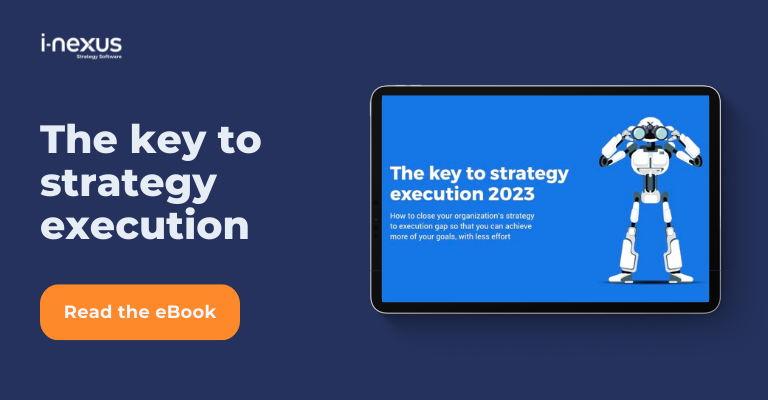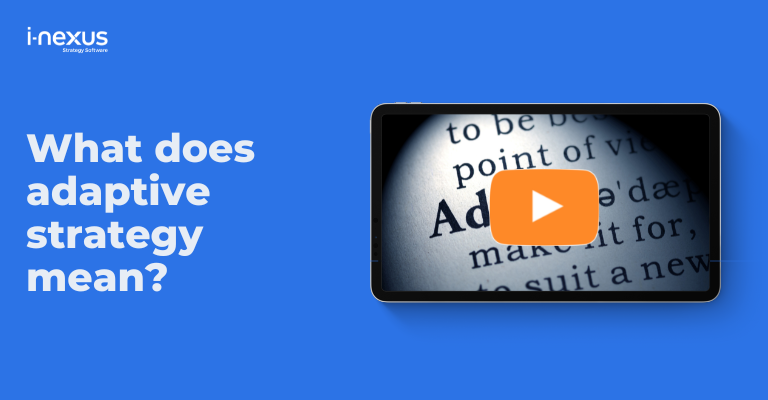As 2023 takes shape, these are 6 key Strategic Portfolio Management (SPM) trends the i-nexus team recommends CSOs and SROs keep in mind.
Written by: James Milsom, Head of Marketing
Another year and another stage in your strategic portfolio's lifecycle mean a fresh set of challenges and some returning favorites. So, what are the key Strategic Portfolio Management trends for this year?
Before we get into it, let's not forget that managing strategic portfolios is a delicate balancing act of work management, program execution, and stakeholder engagement. So, bravo on the continued dedication.
With our 2022 list of Strategic Portfolio Management trends, you'll be in a better place to anticipate where the practice is heading, and what you could do to make this a year of renewed enthusiasm.
From the importance of data fabric, and agile processes, to total demand and resource planning, these are the i-nexus key strategic portfolio management topics for 2023.
1. Innovative Strategic Management
In recent years, companies have succeeded by utilizing concepts like innovation centers to unleash the agility needed to compete in today's market.
Agile has inspired the growth of self-forming teams, in which the team influences what they work on and may alter depending on market conditions.
Innovation centers and self-forming teams have enhanced time-to-market and the flexibility to match with client demand. That makes it difficult to figure out what the company is working on at any one time or in a single place.
The role of a Strategy Realization Office will be pivotal in taking these Agile principles and applying them to strategy execution processes. That means your portfolio management can enjoy the flexibility and enhanced time to market of these innovation centers, but in a way that is aligned to your strategic plan.
2. Data Fabric
Enter SPM and business analytics solutions to underpin the innovation approach.
The way CSOs organize, allocate, and track work has transformed, in large part due to the growing body of expertise in SPM, and strategy execution solutions such as i-nexus.
At the core of your portfolio management is the imperative to know, at all times, the delivery and results of strategic programs, rolled up into a portfolio view. It's simply good practice and logical when you consider the sheer number of moving parts in your SPM efforts.
With an SRO and PMO handed such a solution, coupled with the regular entry of KPI data, your data's fabric is almost Teflon-like. The data will provide Heads of Strategy with interactive visualizations, delivery dashboards, and only help in growing their portfolio analytical skills.
Simply put, an investment in strategy execution software gives the SRO and c-suite the tools to make real-time choices with data insights at their fingertips.
3. Lean Strategic Management
Over the course of 2022, we've increasingly spoken to teams with a Lean approach. And, when you think about it, it's a sensible skill set to use as a foundation for managing strategic programs.
So naturally, we anticipate Lean and Agile thinking to shape the future of SPM. They're not going anywhere. They are widely used as plant / product line level teams increasingly shape strategy delivery.
As use within businesses increased, so will the need to change organizational procedures.
That necessity is driven by how hard it is for the SRO and PMO to combine Agile, conventional projects, and strategic programs into a unified portfolio view.
Adopting the principles of Agile into your portfolio is a step forward, and when combined with growing use of Lean management thinking in the portfolio community, we find a leap!
That means looking at reducing waste in the processes around planning, executing, and tracking your portfolio and bringing process experts from across the business to work with your EPMO / SRO to build a finely-tuned approach.

SPM practitioners can begin to rely on a high-quality data fabric
4. Strategy Realization Offices As A Strategic Portfolio Central Nervous System
This trend is really about proving the value of your strategic portfolio. Finally, there is a way to easily demonstrate results, financial and non-financial, thanks to a tech stack for SROs with includes strategy execution software.
And that leads to your SRO becoming the central nervous system for your portfolio. That's because the SRO acts as connective tissue between the strategy and the portfolio's management (and execution for that matter).
That leads to insights that would have typically taken great manual work in spreadsheets and powerpoints can be generated at the click of a button (or, better yet, automated via email).
So, the elusive strategy-to-execution gap begins to be addressed thanks to an SRO. CSOs can be confident their strategic plan is well-formulated, and key strategic objectives are translated to portfolios of programs - all easily tracked, and aligned to the day to day running of plants, product lines, and the business as a whole.
The result is a data-rich, insight delighting era of SPM where CSOs can demonstrate to their CFO, CEO, and COO exactly how the portfolio is shaping up.
5. Total Demand And Resource Planning
With that SRO central nervous system feeding benefit realization reporting, so too comes vastly-improved internal communication and collaboration across planning out available resources for strategic portfolios.
Why? Because the data is available to forecast demand and analyze results, which can only serve for better program prioritization and assessment against your prioritization matrix.
As we know, demand management is the structure or process for managing all new projects, initiatives, goods, and services within your company. And trying to figure out how to balance your organization's resource demands with its actual capacity to meet those demands requires accurate, timely information.
Because we are in a fast-paced world, it's critical for businesses to connect their expenditures and investments in the future with their long-term objectives.
So, you must concentrate on the issues that have the most strategic value for the company.
You won't correctly identify who is working on what if you don't have enough demand management systems in place which, naturally, tie into strategic portfolio delivery.
6. Rethinking How Value Is Delivered
Measurement of return on investment has traditionally been the most critical parameter in Portfolio Management.
However, there has been a transition from project and program delivery to products in recent years, and subsequently from products to services.
Companies considering how to give the most outstanding value to their customers through a Lean Strategic Portfolio Management mindset must also consider how to quantify that value.
With this growing awareness of supporting value streams rather than traditional value delivery and measurement, comes the need to broaden our understanding of value streams, and how to maximize our operational efforts to generate more from our portfolio.
In many companies, the challenge is figuring out how to transition to an adaptive Strategic Portfolio Management model that focuses on value delivery while optimizing traditional and Agile approaches to delivering that value.
You should determine how to implement Strategy Portfolio Management fundamentals in this adaptive environment - which means embracing an Adaptive Strategy.
Wrapping Up 2022 Strategic Portfolio Management
Strategic Portfolio Management is changing at the same rate as the companies that use it as we move throughout 2023.
These are a sample of the trends which we feel are going to shape your daily efforts, and we anticipate our conversations with you will likely centre around tackling these challenges in an effective way.
Because the trends are intertwined, different technology combinations compete at various stages of the company's growth cycle.
Understanding their firms' short and long-term business objectives will help CSOs to choose the right path for their strategic management, but what is certain is that adapting our ways of working, creating new processes, and getting every ounce of value out of strategy execution software is crucial to a year of SPM success.
Learn More About Strategic Portfolio Management
Click here to learn more about the role of SPM in executing your strategy or take a look at these content recommendations:
- Read Our Strategic Portfolio Management 101: Strategic Portfolio Management is becoming increasingly popular as more businesses look to optimize and improve their time to market, address their CAPEX, achieve their ESG targets, and realize their strategic goals - so what does it all mean?
- The Key To Strategy Execution: Read our eBook to help you with implementing a new strategic portfolio management plan, with advice on how to execute your plan successfully and avoid common mistakes.
- Help Your Business Become Agile: Discover why an adaptive approach to strategic planning and execution begins with Operational Excellence.
About the author
James Milsom is Head of Marketing at i-nexus. James has wide-ranging experience in markets such as telecommunications, energy, education, and software.
As Head of Marketing, his drive is to raise awareness and understanding of the challenges facing enterprises in delivering strategic objectives and transformation amidst changing markets and the obstacles traditional tools and methods present leaders.
If you’d like to talk more about Strategy Execution, reach out to James on james.milsom@i-nexus.com or connect with him on LinkedIn for the latest insights.




